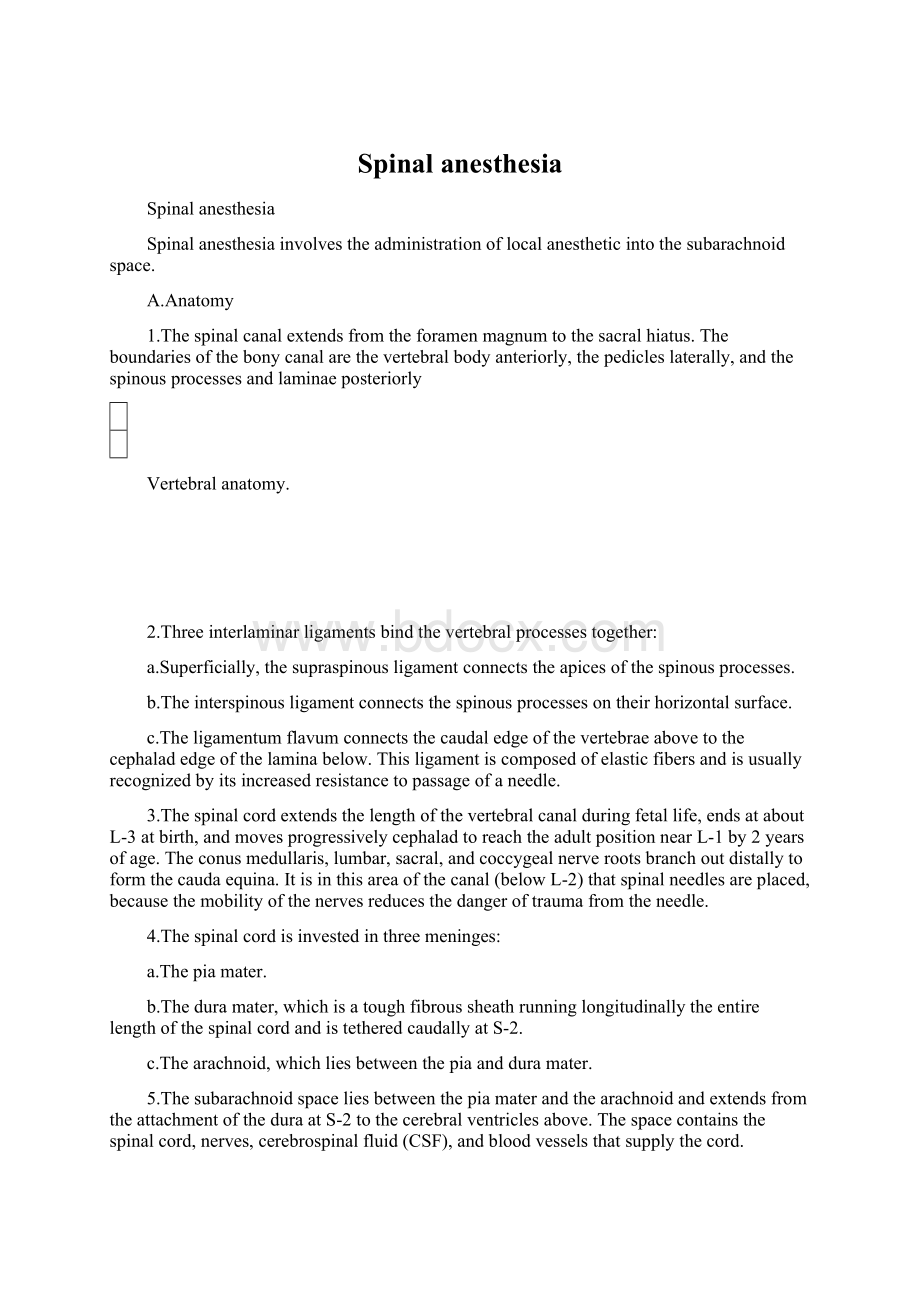Spinal anesthesia.docx
《Spinal anesthesia.docx》由会员分享,可在线阅读,更多相关《Spinal anesthesia.docx(8页珍藏版)》请在冰豆网上搜索。

Spinalanesthesia
Spinalanesthesia
Spinalanesthesiainvolvestheadministrationoflocalanestheticintothesubarachnoidspace.
A.Anatomy
1.Thespinalcanalextendsfromtheforamenmagnumtothesacralhiatus.Theboundariesofthebonycanalarethevertebralbodyanteriorly,thepedicleslaterally,andthespinousprocessesandlaminaeposteriorly
Vertebralanatomy.
2.Threeinterlaminarligamentsbindthevertebralprocessestogether:
a.Superficially,thesupraspinousligamentconnectstheapicesofthespinousprocesses.
b.Theinterspinousligamentconnectsthespinousprocessesontheirhorizontalsurface.
c.Theligamentumflavumconnectsthecaudaledgeofthevertebraeabovetothecephaladedgeofthelaminabelow.Thisligamentiscomposedofelasticfibersandisusuallyrecognizedbyitsincreasedresistancetopassageofaneedle.
3.Thespinalcordextendsthelengthofthevertebralcanalduringfetallife,endsataboutL-3atbirth,andmovesprogressivelycephaladtoreachtheadultpositionnearL-1by2yearsofage.Theconusmedullaris,lumbar,sacral,andcoccygealnerverootsbranchoutdistallytoformthecaudaequina.Itisinthisareaofthecanal(belowL-2)thatspinalneedlesareplaced,becausethemobilityofthenervesreducesthedangeroftraumafromtheneedle.
4.Thespinalcordisinvestedinthreemeninges:
a.Thepiamater.
b.Theduramater,whichisatoughfibroussheathrunninglongitudinallytheentirelengthofthespinalcordandistetheredcaudallyatS-2.
c.Thearachnoid,whichliesbetweenthepiaandduramater.
5.ThesubarachnoidspaceliesbetweenthepiamaterandthearachnoidandextendsfromtheattachmentoftheduraatS-2tothecerebralventriclesabove.Thespacecontainsthespinalcord,nerves,cerebrospinalfluid(CSF),andbloodvesselsthatsupplythecord.
6.CSFisaclearcolorlessfluidthatfillsthesubarachnoidspace.ThetotalvolumeofCSFis100to150mL,whereasthevolumeinthespinalsubarachnoidspaceis25to35mL.CSFiscontinuouslyformedatarateof450mL/daybysecretionorultrafiltrationofplasmafromthechoroidarterialplexuseslocatedinthelateral,third,andfourthventricles.CSFisreabsorbedintothebloodstreamthroughthearachnoidvilliandgranulationsthatprotrudethroughduratolieincontactwiththeendotheliumofthecerebralvenoussinuses.
B.Physiology
1.Neuralblockade.SmallerCfibersconveyingautonomicimpulsesaremoreeasilyblockedthanthelargersensoryandmotorfibers.Asaresult,thelevelofautonomicblockadeextendsabovethelevelofthesensoryblockadebytwotothreesegments.Thisistermeddifferentialblockade.Similarly,fibersconveyingsensationaremoreeasilyblockedthanthelargermotorfiberssothatsensoryblockadewillextendabovethelevelofmotorblockade.
2.Cardiovascular.Hypotensionisdirectlyproportionaltothedegreeofsympatheticblockadeproduced.Sympatheticblockaderesultsindilatationofarteriesandvenouscapacitancevessels,leadingtodecreasedsystemicvascularresistanceanddecreasedvenousreturn.IftheblockisbelowT-4,increasedbaroreceptoractivityproducesanincreaseinactivitytothecardiacsympatheticfibersandvasoconstrictionoftheupperextremities.BlockadeaboveT-4interruptscardiacsympatheticfibers,leadingtobradycardia,decreasedcardiacoutput,andafurtherdecreaseinbloodpressure.Thesechangesaremoremarkedinpatientswhoarehypovolemic,elderly,orhaveobstructiontovenousreturn(e.g.,pregnancy).Theseeffectscanbeminimizedwithprehydration,vasopressors,andanticholinergics.
3.Respiratory.Lowspinalanesthesiahasnoeffectonventilation.Withascendingheightoftheblockintothethoracicarea,thereisaprogressiveascendingintercostalmuscleparalysis.Thishaslittleeffectonventilationinthesupinesurgicalpatientwhostillhasdiaphragmaticfunctionmediatedbythephrenicnerve.Ventilationinpatientswithpoorrespiratoryreserve,suchasthemorbidlyobese,however,maybeprofoundlyimpaired.Bothintercostalandabdominalmuscleparalysisdecreasetheefficiencyofcoughing,whichmaybeimportantinpatientswithchronicobstructivepulmonarydisease.Epiduralanalgesiawithopioidsandlowdoselocalanesthetics,whichproducesminimalmotorblockade,ishelpfulinthepostoperativecareofthoracicsurgicalpatients.
4.Visceraleffects
a.Bladder.Sacralblockade(S2-S4)resultsinanatonicbladderthatisabletoretainlargevolumesofurine.Blockadeofsympatheticefferents(T5-L1)resultsinanincreaseinsphinctertone,producingretention.Aurinarycathetershouldbeplacedifanesthesiaoranalgesiaismaintainedforaprolongedperiod.
b.Intestine.Sympatheticblockade(T5-L1)producedbyspinalanesthesiahasapromotilityeffectonthegutbecauseofpredominanceofparasympathetictone.
5.Renalbloodflowismaintained,becauseofautoregulationbylocaltissuefactors,exceptwithseverehypotension.Urineproductionisusuallyunaffected.
6.Neuroendocrine.PeriduralblocktoT-5inhibitspartoftheneuralcomponentofthestressresponse,throughitsblockadeofsympatheticafferentstotheadrenalmedullaandblockadeofsympatheticandsomaticpathwaysmediatingpain.Othercomponentsofthestressresponseandcentralreleaseofhumoralfactorsareunaffected.Vagalafferentfibersfromupperabdominalvisceraarenotblockedandcanstimulatereleaseofhypothalamicandpituitaryhormones,suchasantidiuretichormoneandadrenocorticotropichormone.Glucosetoleranceandinsulinreleasearenormal.
7.Thermoregulation.Vasodilationofthelowerlimbscanproducehypothermia.
C.Technique
1.Spinalneedle.NewerneedlessuchastheSprotteandWhitacrefeatureapencil-pointdesignwithalateralopening.Theseneedlesmayreducetheincidenceofpostduralpunctureheadache(to≤1%)comparedwithtraditional“cuttingtip”needlesbysplittingratherthancuttingduralfibersduringinsertion.Needlesthatare24and25gaugeareeasilybentandareofteninsertedthrougha19-gaugeintroducerneedle.The22-gaugeQuinckeneedleismorerigidandismoreeasilydirectedandinserted.Itcanbeusefulinolderpatientsinwhomaccessmaybemoredifficultandtheincidenceofpostduralpunctureheadacheislow.
2.Patientposition.Thelateraldecubitus,prone,andsittingpositionscanbeusedforadministrationofspinalanesthesia.
a.Inthelateralposition,thepatientisplacedwiththeaffectedsideupifahypobaricorisobarictechniqueistobeusedandwiththeaffectedsidedownifahyperbarictechniqueistobeused.Thespineishorizontalandparalleltotheedgeofthetable.Thekneesaredrawnuptowardthechestandthechinflexeddownwardontothechesttoobtainmaximalflexionofthespine.
b.Thesittingpositionisusefulforlowspinalblocksrequiredincertaingynecologicandurologicproceduresandiscommonlyusedinobesepatientstoassistinidentificationofthemidline.Itisusedinconjunctionwithhyperbaricanesthetics.TheheadandshouldersareflexeddownwardontothetrunkwiththearmsrestingonaMayostand.Anassistantshouldbeavailabletostabilizethepatient,andthepatientshouldnotbeoversedated.
c.Thepronepositionisusedinconjunctionwithhypobaricorisobaricanestheticsforproceduresontherectum,perineum,andanus.Apronejackknifepositioncanbeusedforbothadministrationofspinalanesthesiaandthesubsequentsurgery.
3.Procedure
a.TheL2-3,L3-4,orL4-5interspacesarecommonlyusedforspinalanesthesia.TheL3-4interspaceorthespinousprocessofL-4arealignedwithupperbordersofthesuperioriliaccrests.
b.Disinfectalargeareaofskinwithanappropriateantisepticsolution.Caremustbetakentoavoidcontaminationofthespinalkitwithantisepticsolution,whichispotentiallyneurotoxic.
c.Checkthestyletforcorrectfitwithintheneedle.
d.Raiseaskinwhealwith1%lidocaineanda25-gaugeneedleatthespinalpuncturesite.
e.Approaches
1.Midline.Placethespinalneedle(orintroducer)throughtheskinwhealandintotheinterspinousligament.Theneedleshouldbeinthesameplaneasthespinousprocessesandangulatedslightlycephaladtowardtheinterlaminarspace.
Spinalneedleinsertion,lateralview.Fortheclassicmidlineapproach,theneedleisintroducedinthemiddleoftheinterspaceandadvancedwithaslightcephaladangulation.Ifcorrectlyangled(A),itwillentertheinterspinousligament,ligamentumflavum,andepiduralspace.Ifboneiscontacted,itmaybetheinferiorspinousprocess(B),andcephaladredirectionwillidentifythecorrectpath.Ifanglingcephaladcausescontactwithboneagainatashallowerdepth(C),itisprobablythesuperiorspinousprocess.Ifboneisencounteredatthesamedepthafterseveralattemptsatredirection(notshown),theneedleismostlikelyonthelaminalateraltotheinterspace,andthepositionofthetruemidlineshouldbereassessed.(FromMulroyMF.Regionalanesthesia:
anillustratedproceduralguide,2nded.Boston:
Little,BrownandCompany,1996:
79,withpermission.)
2.Paramedian.Thisapproachisusefulinpatientswhocannotadequatelyflextheirbackbecauseofpainorwhoseinterspinousligamentsmaybeossified.Placethespinalneedle1.5cmlateralandslightlycaudad(approximately1cm)tothecenteroftheselectedinterspace.Aimtheneedlemediallyandslightlycephalad,passinglateraltothesupraspinousligament.Ifthelaminaiscontacted,redirecttheneedleandwalkthetipoffthelaminainamedialandcephaladdirection.
3.Needleplacement.Alwayskeepthestyletinplacewhenadvancingtheneedlesothattheneedle'slumendoesnotbecomepluggedwithtissue